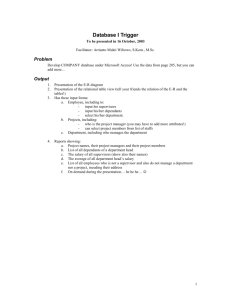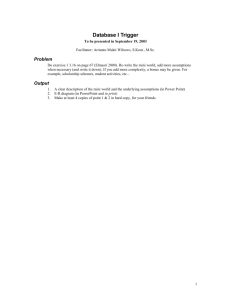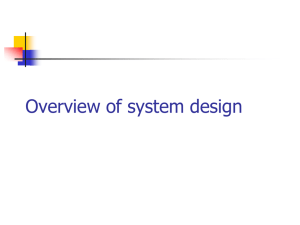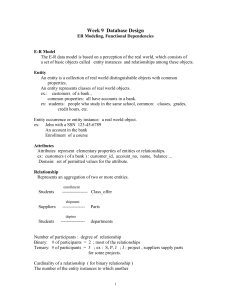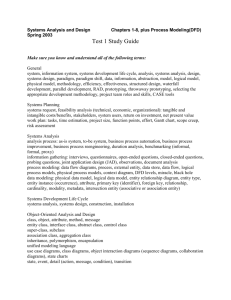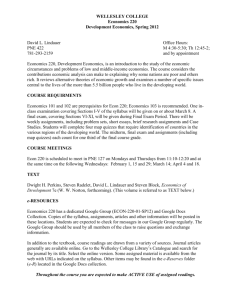Database System Concepts - Chapter 6: Entity
advertisement
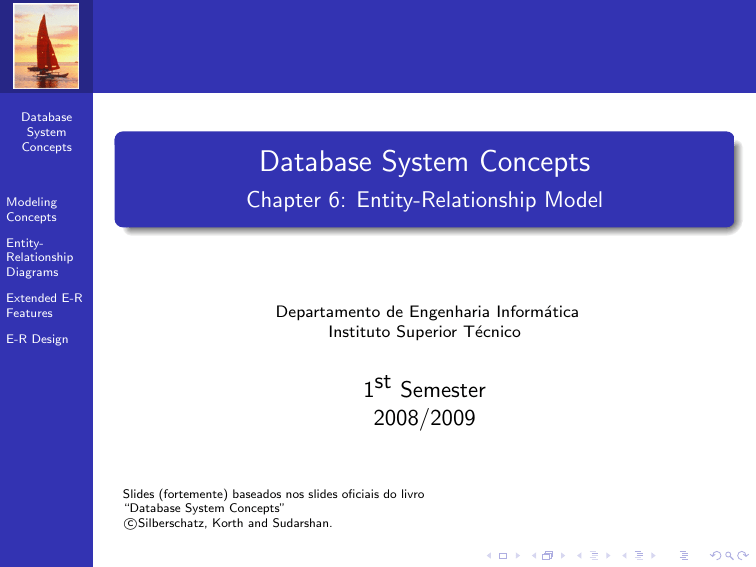
Database
System
Concepts
Modeling
Concepts
Database System Concepts
Chapter 6: Entity-Relationship Model
EntityRelationship
Diagrams
Extended E-R
Features
E-R Design
Departamento de Engenharia Informática
Instituto Superior Técnico
1st Semester
2008/2009
Slides (fortemente) baseados nos slides oficiais do livro
“Database System Concepts”
c
Silberschatz,
Korth and Sudarshan.
Outline
Database
System
Concepts
Modeling
Concepts
EntityRelationship
Diagrams
1
Modeling Concepts
2
Entity-Relationship Diagrams
3
Extended E-R Features
4
E-R Design
Extended E-R
Features
E-R Design
Outline
Database
System
Concepts
Modeling
Concepts
EntityRelationship
Diagrams
1
Modeling Concepts
2
Entity-Relationship Diagrams
3
Extended E-R Features
4
E-R Design
Extended E-R
Features
E-R Design
Modeling
Database
System
Concepts
A database can be modeled as:
Modeling
Concepts
EntityRelationship
Diagrams
Extended E-R
Features
E-R Design
a collection of entities,
relationship among entities.
An entity is an object that exists and is distinguishable
from other objects.
Example: specific person, company, event, plant
Entities have attributes
Example: people have names and addresses
An entity set is a set of entities of the same type that
share the same properties.
Example: set of all persons, companies, trees, holidays
Entity Sets customer and loan
Database
System
Concepts
Modeling
Concepts
EntityRelationship
Diagrams
Extended E-R
Features
E-R Design
Relationship Sets
Database
System
Concepts
A relationship is an association among several entities
Modeling
Concepts
EntityRelationship
Diagrams
Extended E-R
Features
E-R Design
Example: depositor is a relationship between customer
and account
A relationship set is a mathematical relation among n ≥ 2
entities, each taken from entity sets
{(e1 , e2 , . . . , en )|e1 ∈ E1 , e2 ∈ E2 , . . . , en ∈ En }
where (e1 , e2 , . . . , en ) is a relationship
Example:
(Hayes, A − 102) ∈ depositor
Relationship Set borrower
Database
System
Concepts
Modeling
Concepts
EntityRelationship
Diagrams
Extended E-R
Features
E-R Design
Relationship Set Attributes
Database
System
Concepts
Modeling
Concepts
EntityRelationship
Diagrams
Extended E-R
Features
E-R Design
An attribute can also be property of a relationship set.
For instance, the depositor relationship set between entity
sets customer and account may have the attribute
access-date
Degree of a Relationship Set
Database
System
Concepts
Modeling
Concepts
EntityRelationship
Diagrams
Extended E-R
Features
E-R Design
Refers to number of entity sets that participate in a
relationship set.
Relationship sets that involve two entity sets are binary (or
degree two).
Relationship sets may involve more than two entity sets.
Example: Suppose employees of a bank may have jobs
(responsibilities) at multiple branches, with different jobs
at different branches. Then there is a ternary relationship
set between entity sets employee, job, and branch
Relationships between more than two entity sets are rare.
Most relationships are binary.
Attributes
Database
System
Concepts
Modeling
Concepts
EntityRelationship
Diagrams
Extended E-R
Features
E-R Design
An entity is represented by a set of attributes, that is
descriptive properties possessed by all members of an
entity set.
Example:
customer = (customer_id, customer_name,
customer_street, customer_city)
loan = (loan_number, amount)
Domain - the set of permitted values for each attribute
Attribute types:
Simple and composite attributes.
Single-valued and multi-valued attributes
Example: multivalued attribute: phone numbers
Derived attributes
Can be computed from other attributes
Example: age, given date of birth
Mapping Cardinality Constraints
Database
System
Concepts
Modeling
Concepts
EntityRelationship
Diagrams
Extended E-R
Features
E-R Design
Express the number of entities to which another entity can
be associated via a relationship set.
Most useful in describing binary relationship sets.
For a binary relationship set the mapping cardinality must
be one of the following types:
One to one
One to many
Many to one
Many to many
Mapping Cardinalities
Database
System
Concepts
Modeling
Concepts
EntityRelationship
Diagrams
Extended E-R
Features
E-R Design
One to one
One to many
Note: Some elements in A and B may not be mapped to any
elements in the other set
Mapping Cardinalities
Database
System
Concepts
Modeling
Concepts
EntityRelationship
Diagrams
Extended E-R
Features
E-R Design
Many to one
Many to many
Note: Some elements in A and B may not be mapped to any
elements in the other set
Keys
Database
System
Concepts
Modeling
Concepts
EntityRelationship
Diagrams
Extended E-R
Features
E-R Design
A super key of an entity set is a set of one or more
attributes whose values uniquely determine each entity.
A candidate key of an entity set is a minimal super key
Customer id is candidate key of customer
account number is candidate key of account
Although several candidate keys may exist, one of the
candidate keys is selected to be the primary key.
The combination of primary keys of the participating
entity sets forms a super key of a relationship set.
(customer id, account number) is the super key of
depositor
Must consider the mapping cardinality of the relationship
set when deciding the what are the candidate keys
Outline
Database
System
Concepts
Modeling
Concepts
EntityRelationship
Diagrams
1
Modeling Concepts
2
Entity-Relationship Diagrams
3
Extended E-R Features
4
E-R Design
Extended E-R
Features
E-R Design
E-R Diagrams
Database
System
Concepts
Modeling
Concepts
EntityRelationship
Diagrams
Extended E-R
Features
E-R Design
Rectangles represent entity sets.
Diamonds represent relationship sets.
Lines link attributes to entity sets and entity sets to
relationship sets.
Ellipses represent attributes
Double ellipses represent multivalued attributes.
Dashed ellipses denote derived attributes.
Underline indicates primary key attributes
E-R Diagram With Composite, Multivalued, and
Derived Attributes
Database
System
Concepts
Modeling
Concepts
EntityRelationship
Diagrams
Extended E-R
Features
E-R Design
Relationship Sets with Attributes
Database
System
Concepts
Modeling
Concepts
EntityRelationship
Diagrams
Extended E-R
Features
E-R Design
Roles
Database
System
Concepts
Modeling
Concepts
EntityRelationship
Diagrams
Extended E-R
Features
E-R Design
Entity sets of a relationship need not be distinct
The labels “manager” and “worker” are called roles; they
specify how employee entities interact via the works for
relationship set.
Roles are indicated in E-R diagrams by labeling the lines that
connect diamonds to rectangles.
Role labels are optional, and are used to clarify semantics of the
relationship
Cardinality Constraints
Database
System
Concepts
Modeling
Concepts
EntityRelationship
Diagrams
We express cardinality constraints by drawing either a
directed line (→), signifying “one”, or an undirected line
(−), signifying “many”, between the relationship set and
the entity set.
Extended E-R
Features
E-R Design
many-to-many relationship
Cardinality Constraints
Database
System
Concepts
Modeling
Concepts
EntityRelationship
Diagrams
We express cardinality constraints by drawing either a
directed line (→), signifying “one”, or an undirected line
(−), signifying “many”, between the relationship set and
the entity set.
Extended E-R
Features
E-R Design
one-to-many relationship
Cardinality Constraints
Database
System
Concepts
Modeling
Concepts
EntityRelationship
Diagrams
We express cardinality constraints by drawing either a
directed line (→), signifying “one”, or an undirected line
(−), signifying “many”, between the relationship set and
the entity set.
Extended E-R
Features
E-R Design
many-to-one relationship
Participation of an Entity Set in a Relationship Set
Database
System
Concepts
Modeling
Concepts
EntityRelationship
Diagrams
Extended E-R
Features
E-R Design
Total participation (double line): every entity in the entity
set participates in at least one relationship in the
relationship set
E.g. participation of loan in borrower is total: every loan
must have a customer associated to it via borrower
Partial participation: some entities may not participate in
any relationship in the relationship set
Example: participation of customer in borrower is partial
E-R Diagram with a Ternary Relationship
Database
System
Concepts
Modeling
Concepts
EntityRelationship
Diagrams
Extended E-R
Features
E-R Design
Cardinality Constraints:
We allow at most one arrow out of a ternary (or greater
degree) relationship to indicate a cardinality constraint
E.g. an arrow from works on to job indicates each
employee works on at most one job at any branch.
Weak Entity Set
Database
System
Concepts
Modeling
Concepts
EntityRelationship
Diagrams
Extended E-R
Features
E-R Design
An entity set that does not have a primary key is referred
to as a weak entity set.
The existence of a weak entity set depends on the
existence of a identifying entity set
it must relate to the identifying entity set via a total,
one-to-many relationship set from the identifying to the
weak entity set
Identifying relationship depicted using a double diamond
The discriminator (or partial key ) of a weak entity set is
the set of attributes that distinguishes among all the
entities of a weak entity set.
The primary key of a weak entity set is formed by the
primary key of the strong entity set on which the weak
entity set is existence dependent, plus the weak entity
set’s discriminator.
Weak Entity Set (cont.)
Database
System
Concepts
Modeling
Concepts
EntityRelationship
Diagrams
Extended E-R
Features
E-R Design
We depict a weak entity set by double rectangles.
We underline the discriminator of a weak entity set with a
dashed line.
payment number - discriminator of the payment entity set
Primary key for payment - (loan number,
payment number)
Outline
Database
System
Concepts
Modeling
Concepts
EntityRelationship
Diagrams
1
Modeling Concepts
2
Entity-Relationship Diagrams
3
Extended E-R Features
4
E-R Design
Extended E-R
Features
E-R Design
Specialization/Generalization
Database
System
Concepts
Modeling
Concepts
EntityRelationship
Diagrams
Extended E-R
Features
E-R Design
Depicted by a triangle component labeled ISA (E.g. customer
“is a” person).
Attribute inheritance - a lower-level entity set inherits all the
attributes and relationship participation of the higher-level
entity set to which it is linked.
Constraints on a Specialization/Generalization
Database
System
Concepts
Modeling
Concepts
EntityRelationship
Diagrams
Extended E-R
Features
E-R Design
Constraint on whether or not entities may belong to more
than one lower-level entity set within a single
generalization.
Disjoint - an entity can belong to only one lower-level
entity set
Noted in E-R diagram by writing disjoint next to the ISA
triangle
Overlapping - an entity can belong to more than one
lower-level entity set
Completeness constraint specifies whether or not an entity
in the higher-level entity set must belong to at least one of
the lower-level entity sets within a generalization.
Total - an entity must belong to one of the lower-level
entity sets
Noted in E-R diagram by a double line over the ISA
triangle
Partial - an entity need not belong to one of the lower-level
entity sets
Aggregation
Database
System
Concepts
Modeling
Concepts
EntityRelationship
Diagrams
Extended E-R
Features
E-R Design
Consider the ternary relationship works on, which we saw earlier
Suppose we want to record managers for tasks performed by an
employee at a branch
Outline
Database
System
Concepts
Modeling
Concepts
EntityRelationship
Diagrams
1
Modeling Concepts
2
Entity-Relationship Diagrams
3
Extended E-R Features
4
E-R Design
Extended E-R
Features
E-R Design
Design Issues
Database
System
Concepts
The use of an attribute or entity set to represent an object.
Modeling
Concepts
EntityRelationship
Diagrams
Extended E-R
Features
E-R Design
Whether a real-world concept is best expressed by an
entity set or a relationship set.
The use of a ternary relationship versus a pair of binary
relationships.
The use of a strong or weak entity set.
The use of specialization/generalization - contributes to
modularity in the design.
The use of aggregation - can treat the aggregate entity set
as a single unit without concern for the details of its
internal structure.
Mapping Cardinalities affect ER Design
Database
System
Concepts
Modeling
Concepts
EntityRelationship
Diagrams
Extended E-R
Features
E-R Design
Can make access-date an attribute of account, instead of
a relationship attribute, if each account can have only one
customer
Mapping Cardinalities affect ER Design
Database
System
Concepts
Modeling
Concepts
EntityRelationship
Diagrams
Extended E-R
Features
E-R Design
Can make access-date an attribute of account, instead of
a relationship attribute, if each account can have only one
customer
E-R Diagram for a Banking Enterprise
Summary of Symbols Used in E-R Notation
Database
System
Concepts
Modeling
Concepts
EntityRelationship
Diagrams
Extended E-R
Features
E-R Design
End of Chapter 6

